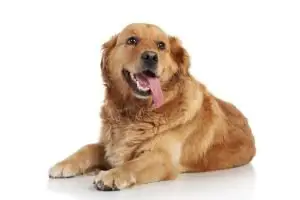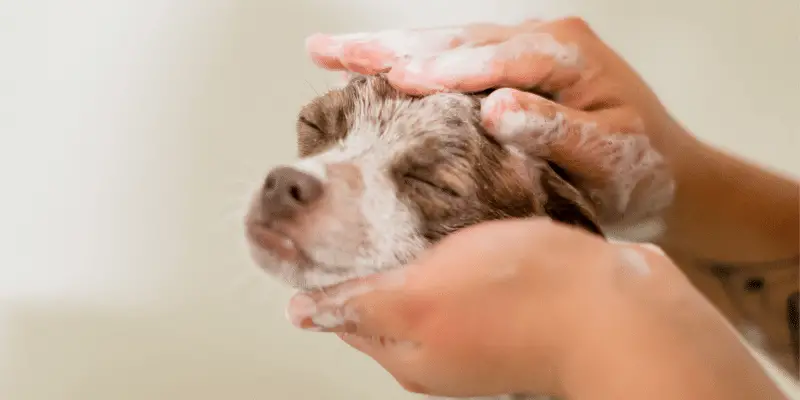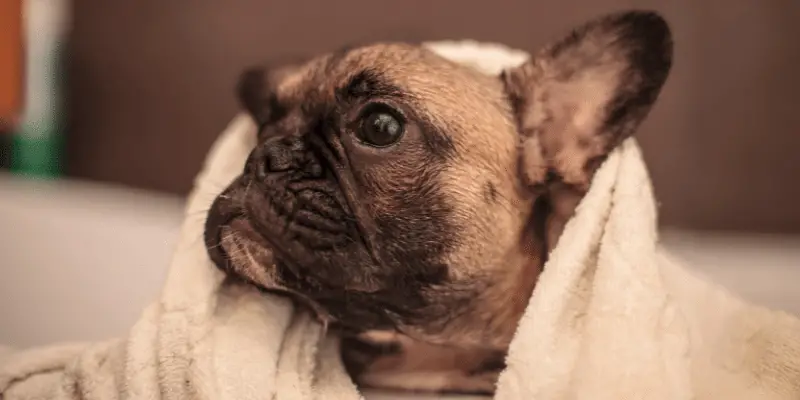



Before you bathe your puppy for the first time, you’ll need to determine their coat type to help you select the right shampoo and method. For instance, smooth-haired dogs like pugs and French bulldogs need shampoos that are gentle and non-drying. Bath time should also be short and quick.
These types of dogs don’t need as frequent baths as long or curly-haired dogs such as golden retrievers and German shepherds, both of which need products that penetrate their undercoats and thick fur.
Your puppy’s first bath will no doubt be an overwhelming and nerve-racking experience, so to make the process go as smoothly as possible, provide encouragement by offering your puppy treats, cuddles, and praise.
It’s important to establish a positive association with bath time from a young age to reduce problems in the future.
Young puppies don’t need shampoos or cleansing products – just a simple washcloth will do the trick. Start with lukewarm water so you don’t burn your pup’s sensitive skin, then use a wet cloth or rag to gently wash your pooch’s body.
Once your puppy is around 3 months old, you can begin using shampoo to give your pup a deeper clean. Make sure you only use shampoos designed for dogs as human shampoos are harsher and higher in acidity.
Bathe a puppy as you would a baby – don’t scrub or drench your pooch in water. Use a soft stream of water and gentle motions, making sure to move your hands in the same direction that your pup’s hair rests.




Soapy eyes aren’t fun for anyone, including your puppy, so when you’re using shampoo on your pooch, avoid their eyes, nose, and ears. Only use a minimal amount of soap around your puppy’s face.
Once your puppy is lathered up, it’s now time to rinse away all the suds and grime. Use lukewarm water to remove all the soap from your companion’s body until the water runs clear.
Dog conditioners work the same way as human conditioners – they help soften hair and keep it moisturized. Using conditioner on your puppy will help prevent dry skin and fur, as well as give it a luscious and silky smooth finish.
Like with shampoo, make sure you rinse your puppy thoroughly after using conditioner.
After your puppy’s bath, it’s important to get them dry quickly so they don’t catch a chill. While you can use a towel, a hairdryer will get your puppy dryer more effectively and rapidly. Use the device on the lowest setting and make sure you move it around often.
Most dogs need baths monthly to keep their coats clean and odor-free, so make sure you stick to a consistent bathing schedule. The more you bathe your puppy, the quicker they will become accustomed to the experience.
There are a few methods you can use to dry your puppy after they’ve had a bath, including towel drying, air drying, and blow-drying.
To towel dry your puppy, grab a thick towel and press it against your pooch’s fur to soak up excess moisture. Repeat the process until your puppy is almost completely dry. If the towel becomes overly wet, use a clean one.
Try to avoid rubbing your puppy’s coat, especially if they have long or curly fur, as this can lead to mats and tangles.
Leaving your puppy to air dry is another option, but don’t be surprised if your pooch rolls around the house and rubs against your furniture! All dogs do this to get dry quickly and to try and get rid of the new ‘clean’ scent.
Air drying isn’t recommended for puppies with long, thick fur or double coats as it will take a considerable amount of time for them to dry off. Additionally, this method can lead to mats and knots, as well as skin infections in humid weather.
The quickest method for drying your puppy after a bath is by simply using a hairdryer. You’ll need to introduce your puppy gradually to the equipment so they can get used to both the noise and sensation.
When using a hairdryer on your puppy, put it on the lowest setting and keep the nozzle a couple of inches from your companion’s fur. Make sure you constantly move the nozzle so the heat is evenly distributed on your pup’s body.



If you’ve noticed your puppy getting a surge of hyperactivity after they’ve had a bath, don’t worry, you’re not alone. Post-bath zoomies are a common occurrence in dogs and usually manifest as intense rolling, running, and shaking, often accompanied by growling or barking.
Your pooch may also rub against carpet, rugs, furniture, or anything else they can get their paws on.
But why do puppies get the zoomies after a bath? The zoomies are usually triggered by pent-up energy, and baths can lead to a build-up of nervous energy. Dogs engage in this odd behavior to release that energy, dry themselves off quicker, and remove the strange “new” smell (in other words, that clean feeling!).
While it’s important to keep your puppy’s coat clean and stick to a regular bathing routine, there are times when bathing your puppy can do more harm than good. For instance, puppies younger than 8 weeks old should not be bathed as they are unable to regulate their own body temperature at this age.
Another occasion when you should avoid giving your puppy is when they are sick, such as with severe diarrhea. The stress of a bath could make the illness worse. Speak to your vet if your pup is ill to check whether they are well enough for a bath.
If you’ve noticed your puppy shivering after their bath, it’s very rarely a cause for concern and is likely due to the sudden change of temperature or a case of the nerves. However, keep a close eye on your pooch to make sure their shivering isn’t linked to pain or an illness such as canine distemper.
There are a few possible reasons why a puppy shivers after a bath, though the most common is simply because of the temperature change – going from a warm bath to cool air is likely to make anyone shiver.
Alternatively, your puppy may be overwhelmed or stressed after their bath, especially if they are not used to the experience, so a case of the shivers may be due to anxiety. Reassure your puppy during and after their bath to let them know there’s nothing to be frightened about.
To prevent your puppy from shivering after their bath, use plenty of praise during the procedure to help calm them down. Be gentle and make sure you don’t get soap in their eyes, ears, or nose – that’s bound to make anyone upset.
Offer your puppy a treat after their bath to build up their confidence and help them view the process as a positive.
You should make sure the bath water is around the same temperature as your house so there’s less of a shock when you get your puppy out of the tub. Double-check the temperature of the bathwater too! An overly cold or hot bath isn’t a pleasant experience for anyone.
Dry your puppy off quickly, either with a towel or a hairdryer so they don’t catch a chill.
Using a hairdryer to dry your puppy is a great way to quickly remove excess moisture from their coat. In fact, it’s probably the best method for drying your pooch, especially if they are long or curly-haired.
Bathing a young puppy is no easy feat, but by following our quick and easy steps mentioned earlier in this article, you’ll be washing your pooch like a pro in no time. Remember to only bathe puppies over the age of 8 weeks (12 weeks when using shampoo) and use plenty of encouragement to build your pup’s tolerance.